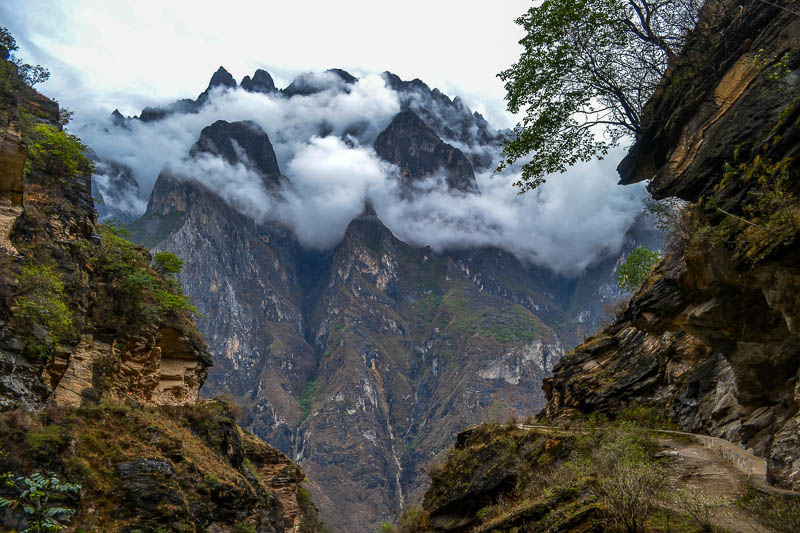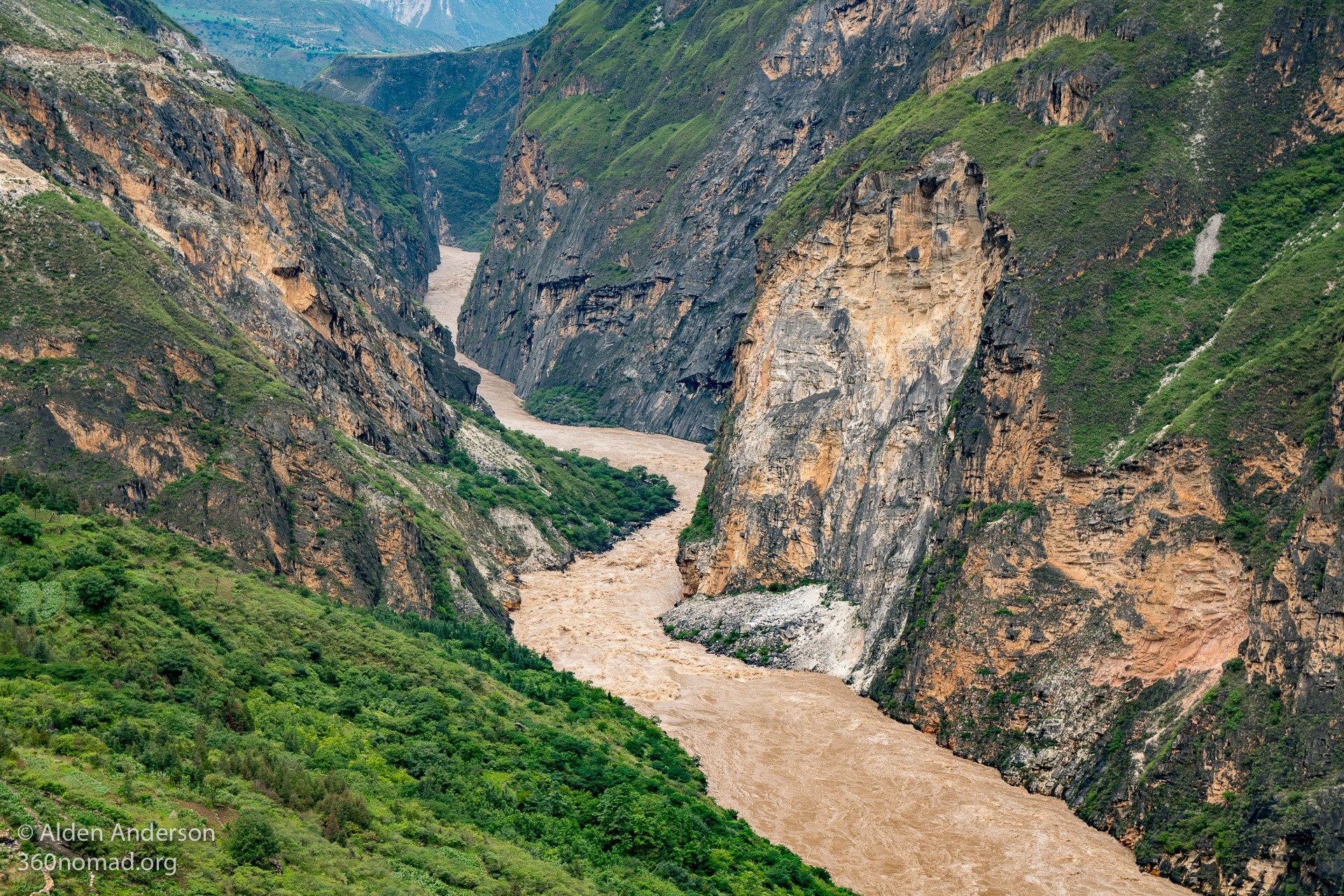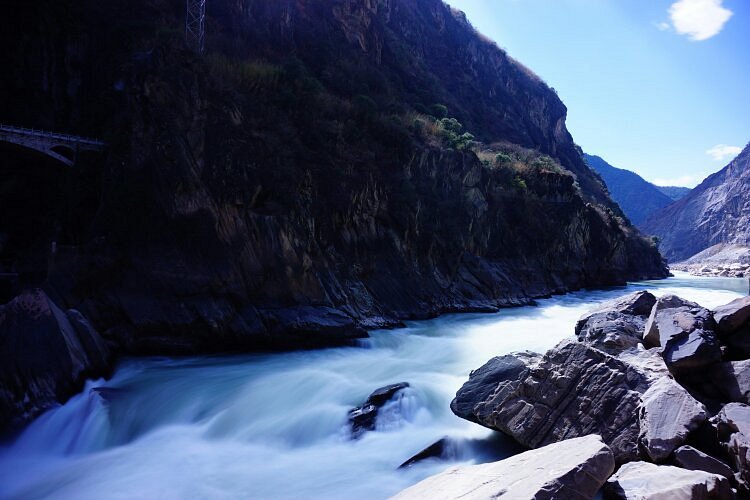Discover the Majesty of Tiger Leaping Gorge: A Hiker’s Paradise

An Essential Guide to Visiting Tiger Leaping Gorge
Imagine standing on the edge of a towering cliff, where the majestic peaks of the Jade Dragon Snow Mountain and Haba Snow Mountain frame a dramatic canyon below. The roar of the Jinsha River echoes through the air, its turquoise waters surging powerfully between steep walls that plummet thousands of feet. Welcome to Tiger Leaping Gorge, one of the most breathtaking natural wonders in China and a hiker’s dream come true.
Nestled in the heart of Yunnan Province, this spectacular gorge is not just a feast for the eyes; it’s a rich tapestry of culture and adventure waiting to be explored. Named after a legendary tiger that leapt across the gorge to escape hunters, this legendary site draws travelers from around the globe, eager to experience its stunning landscapes and the thrill of its trails.
Whether you’re a seasoned hiker looking for your next challenge or a casual adventurer seeking a unique experience, Tiger Leaping Gorge offers a variety of trails that cater to all levels of fitness. The iconic trek through the gorge provides an unparalleled opportunity to immerse yourself in the region’s stunning biodiversity while engaging with the vibrant local culture of the Naxi people.
As you lace up your hiking boots and prepare to navigate this awe-inspiring terrain, let this essential guide illuminate the path ahead. From practical tips on how to get there to the best times to visit and the must-see highlights along the way, everything you need for an unforgettable journey through Tiger Leaping Gorge is right here. Prepare for an adventure that will leave you breathless—not only from the altitude but from the sheer beauty that surrounds you.
In This Guide
- An Essential Guide to Visiting Tiger Leaping Gorge
- The Rich History and Legends of Tiger Leaping Gorge
- Main Highlights: What You Absolutely Can’t Miss
- Planning Your Visit: A Practical Guide
- Tickets: Prices, Booking, and Tips
- How to Get There: A Complete Transportation Guide
- Local Cuisine and Accommodation Nearby
- Frequently Asked Questions
- Final Thoughts on Your Trip
The Rich History and Legends of Tiger Leaping Gorge
Tiger Leaping Gorge, known in Mandarin as 虎跳峡 (Hǔ tiào xiá), is not just a natural wonder; it is steeped in rich history and captivating legends that resonate with the local culture and heritage of Yunnan Province. This stunning gorge, carved by the Jinsha River, has served as a backdrop for tales of bravery and survival, contributing to its mystique and allure for travelers.
One of the most famous legends surrounding Tiger Leaping Gorge narrates the tale of a fierce tiger pursued by hunters. As the story goes, the tiger, cornered and desperate, leaped across the river at its narrowest point—an astounding jump of approximately 25 meters (82 feet). This act of daring not only gave the gorge its name but also transformed it into a symbol of resilience against adversity. The legend has been passed down through generations, embodying the spirit of the region’s indigenous peoples who have coexisted with the dramatic landscape for centuries.
Historically, the gorge has been a critical passageway for various ethnic groups, including the Naxi and Yi people. The Naxi, known for their unique matriarchal society and distinctive Dongba culture, have long inhabited the area, preserving their ancient traditions, including music, dance, and art. The blend of ethnic diversity within the gorge reflects the broader tapestry of Yunnan Province, which is home to numerous ethnic minorities, each contributing to the region’s rich cultural heritage.
Archaeological findings suggest that humans have lived in the area surrounding Tiger Leaping Gorge for thousands of years. The region’s strategic location along ancient trade routes facilitated interactions between different cultures, particularly during the heyday of the Tea Horse Road—a historic trade route that linked China to Tibet and beyond. Merchants traversed these paths, trading tea, horses, and other goods, leaving behind a legacy of cultural exchange that can still be felt today.
The gorge itself was first opened to foreign tourists in 1993, although adventurous travelers had been visiting since the early 1980s. This influx of visitors has not only brought global attention to the area’s natural beauty but has also helped local economies thrive through tourism. Despite the growing number of visitors, Tiger Leaping Gorge retains a sense of untouched wilderness, with its dramatic cliffs, rushing waters, and breathtaking views that inspire awe in all who venture there.
As you traverse the trails of Tiger Leaping Gorge, you walk in the footsteps of both ancient legends and a vibrant cultural history. The stories of the tiger’s leap and the enduring spirit of the Naxi people infuse the landscape with a sense of magic, inviting you to connect with a place that is as much about its past as it is about its present. Whether you are hiking through the rugged terrain or gazing at the towering cliffs, the rich history and legends of Tiger Leaping Gorge will envelop you, making your journey an unforgettable adventure.

Tiger Leaping Gorge.
Main Highlights: What You Absolutely Can’t Miss
Tiger Leaping Gorge, one of the deepest river canyons in the world, offers an unforgettable adventure for international travelers seeking stunning landscapes and rich cultural experiences. Here’s a detailed guide to the main highlights you absolutely can’t miss during your visit.
The Legend of the Gorge
Before you dive into the breathtaking scenery, take a moment to appreciate the legend that gave Tiger Leaping Gorge its name. According to folklore, a hunted tiger leaped across the narrowest point of the river, using a rock in the middle as a springboard. This fantastic tale adds an element of mystique to your journey, reminding you of the area’s deep cultural roots.
Majestic Scenery
The gorge spans approximately 10 miles between the towering Jade Dragon Snow Mountain and Haba Snow Mountain, with cliffs soaring over 2,000 meters (around 6,600 feet) high. As you hike, you’ll be treated to sweeping views of the Jinsha River below, its waters rushing through the canyon, creating a harmonious symphony of nature’s power. The dramatic landscapes change with each step, from lush vegetation to rocky outcrops, each offering a unique perspective on one of China’s most stunning natural wonders.
The Hiking Experience
For those ready to lace up their hiking boots, the upper trail is a must-do. This two-day trek is not only a physical challenge but also a visual feast. Expect to navigate the infamous 28 bends—a series of steep switchbacks that will test your stamina but reward you with spectacular vistas. The hike typically takes 6-8 hours on the first day, leading you to the cozy Halfway Guesthouse, where you can refuel and enjoy panoramic views from the rooftop.
Cultural Encounters
As you hike, keep an eye out for the Naxi minority group, whose rich culture and traditions are woven into the fabric of the region. Small villages dot the landscape, offering glimpses into local life. Engage with locals at guesthouses and along the trail, and perhaps try some traditional Tibetan cuisine to enhance your cultural experience.
Waterfall Wonders
Don’t miss the breathtaking waterfalls along the trail, especially during your second day of hiking. The sight of cascading water framed by rugged mountains is nothing short of magical. These natural wonders serve as perfect backdrops for memorable photos and quiet moments of reflection.
The Bottom of the Gorge
If time allows, consider hiking down to the bottom of the gorge. The descent offers an entirely different perspective, where the roar of the Jinsha River is more pronounced. This section of the trek is less defined, adding a sense of adventure as you navigate your way through diverse paths. The climb back up will leave you with a sense of accomplishment and awe at the canyon’s sheer scale.
Practical Tips
- Timing: The best months to visit are April, May, August, September, and October for optimal weather conditions.
- Stay Hydrated: Bring ample water and snacks, as there are few places to replenish supplies along the trail.
- Safety in Numbers: If you’re hiking solo, connect with fellow travelers to form a group. This not only enhances safety but also enriches the experience.
- Prepare for Weather: Dress in layers, and be prepared for sudden weather changes. Waterproof jackets are advisable, as conditions can vary.
A journey through Tiger Leaping Gorge is more than just a hike; it’s an immersion in nature’s splendor and a chance to connect with the vibrant cultures of Yunnan Province. Whether you’re conquering the trails or soaking in the views, this destination is sure to leave an indelible mark on your travel memories.

Tiger Leaping Gorge.
Planning Your Visit: A Practical Guide
Planning Your Visit: A Practical Guide to Tiger Leaping Gorge
Tiger Leaping Gorge, one of China’s most stunning natural wonders, offers travelers an unforgettable hiking experience amid breathtaking landscapes and rich cultural heritage. To ensure your visit is smooth and enjoyable, here are some essential tips and guidelines for planning your adventure.
Best Time to Visit
The ideal months for hiking Tiger Leaping Gorge are April, May, August, September, and October. During these periods, you can expect drier weather and clearer skies, perfect for enjoying the magnificent views. Summer (June to August) can bring rain, while winter temperatures may drop significantly, so plan accordingly.
Getting There
Starting Point: The trek begins in Qiaotou, a small town easily accessible from Lijiang or Shangri-La.
-
By Train: You can take a sleeper train or a bullet train to Lijiang from various cities in China. If you’re already in Yunnan Province, the bullet train is a convenient option.
-
By Bus: From Lijiang, catch the number 13 bus from the bus station, which costs around 24 Yuan (less than $4). Ensure to book your tickets a day in advance to secure a seat, as this bus departs at 8:30 AM.
-
Shuttle Services: Many guesthouses in Lijiang offer shuttle services to Qiaotou, typically departing around 7:15 AM for about 40 Yuan ($6). This option is recommended as it saves you the hassle of navigating to the bus station.
Upon arrival in Qiaotou, you will be required to purchase an entry ticket for 65 Yuan ($9). The bus may continue to Jane’s Tibetan Guesthouse, where you can collect a map and store any extra luggage for a small fee.
Choosing Your Trail
The Upper Route: This is the most popular and scenic hiking route. The trek is usually completed over two days, with an overnight stay in a local guesthouse. While physically demanding, it’s accessible to anyone with a moderate fitness level.
-
Day 1: Expect to hike for 6-8 hours, with challenging sections in the first couple of hours. Key highlights include the Naxi Guesthouse and the infamous 28 bends. Many hikers choose to stay at Halfway Guesthouse for its stunning views and comfortable accommodations.
-
Day 2: The remaining hike is shorter and takes about two hours. It features a beautiful waterfall and winding trails. Make sure to return to Tina’s Guesthouse for lunch before heading back to Lijiang.
Essential Preparations
-
Group Hiking: If you’re traveling solo, try to join others for safety and companionship. Meeting fellow travelers in hostels or guesthouses can lead to new friendships and shared experiences.
-
Check Conditions: Before setting off, inquire about trail and weather updates at hostels or cafes in Lijiang or Qiaotou. The trail may close in adverse weather conditions.
-
Packing Essentials:
- Footwear: Sturdy hiking boots are highly recommended. Trails can be slippery, especially in damp conditions.
- Clothing: Dress in layers as temperatures can vary, and don’t forget a waterproof jacket.
- Sun Protection: Bring sunscreen and lip balm, as much of the trail lacks shade.
-
Hydration and Snacks: Carry ample water and snacks; local vendors sell refreshments along the route.
-
Cash: Keep small denominations handy for entrance fees, snacks, and other expenses.
Additional Tips
- Photography: Don’t miss the opportunity to capture the stunning views of the Jade Dragon and Haba mountains, along with the roaring Jinsha River below.
- Cultural Experience: Take time to appreciate the rich culture of the local Naxi minority, who still maintain many of their traditional practices.
Conclusion
Tiger Leaping Gorge is not just a hike; it’s a journey through some of China’s most awe-inspiring landscapes and cultural treasures. With proper planning and preparation, your adventure will be both memorable and exhilarating. Embrace the beauty of nature, the thrill of exploration, and the warmth of local hospitality on your visit to this iconic destination.

Tiger Leaping Gorge.
Tickets: Prices, Booking, and Tips
When planning your adventure to Tiger Leaping Gorge, understanding the ticketing process, prices, and some essential tips can enhance your experience significantly. Here’s what you need to know:
Entrance Fees
To enter the breathtaking Tiger Leaping Gorge, you’ll need to purchase an entrance ticket, which costs 65 Yuan (approximately $9.50 USD). This fee is collected at the gorge entrance, and it’s advisable to keep some small notes handy for this and other minor expenses during your hike.
Booking Your Tickets
While tickets can be purchased on-site, it’s wise to plan ahead, especially during peak hiking seasons. If you’re traveling from Lijiang, you can buy your bus ticket in advance. The journey typically takes about 2.5 hours, and the bus departs from the Lijiang bus station at 8:30 AM. It costs around 24 Yuan (under $4 USD). Booking your bus ticket a day in advance will help ensure you secure a seat, as buses can fill up quickly.
Travel Options to the Gorge
- From Lijiang: You can take a sleeper train or a bullet train to Lijiang, then catch a local bus or shuttle to the gorge. Alternatively, accommodations in Lijiang often offer shuttle services to the gorge, which can be more convenient and comfortable.
- From Qiaotou: This is the starting point for most hikes in the gorge. After arriving, an attendant from the Tiger Leaping Gorge tourist office will provide your entrance tickets on the bus.
Additional Costs
- Guesthouses: If you plan to hike the gorge over two days, accommodations like Halfway Guesthouse or Tina’s Guesthouse offer affordable lodging with stunning views. Prices vary but are generally reasonable.
- Luggage Storage: If you have extra gear, you can store your luggage at Jane’s Tibetan Guesthouse for a small fee of 5 Yuan (around $0.75 USD).
- Trail Fees: There’s a 15 Yuan fee (about $2.20 USD) to access the lower trail, which is worth it for those wanting to experience the gorge from different angles.
Tips for a Smooth Experience
- Travel in Groups: If you’re hiking solo, connect with fellow travelers in your accommodation to form a group. Not only is it safer, but it also makes for a more enjoyable experience.
- Check Conditions: Always check trail and weather conditions before setting out, as the trail can be closed during adverse weather.
- Pack Smart: Bring plenty of water, snacks, sunscreen, and a waterproof jacket. The trail has little shade, and the weather can change rapidly.
- Enjoy Local Offerings: Locals along the trail often sell snacks and drinks, so you can refuel without carrying too much.
By keeping these ticketing details and tips in mind, you’ll be well-prepared to explore the stunning landscapes and rich culture that Tiger Leaping Gorge has to offer. Enjoy your hike!
How to Get There: A Complete Transportation Guide
Reaching Tiger Leaping Gorge is an adventure in itself, and there are several transportation options available that make it accessible for international travelers. Here’s a step-by-step guide on how to get there, starting from major cities in Yunnan Province.
Getting to Lijiang
Most travelers begin their journey to Tiger Leaping Gorge from Lijiang, a charming city known for its ancient architecture and beautiful surroundings.
By Air
The Lijiang Sanyi Airport (LJG) serves both domestic and limited international flights. If you’re coming from larger cities like Beijing, Shanghai, or Kunming, you can catch a direct flight to Lijiang. From the airport, you can take a taxi or a shuttle bus to the city center.
By Train
For those already within Yunnan Province, taking a train can be both comfortable and scenic. A sleeper train from cities like Kunming to Lijiang is a popular choice. Bullet trains also connect Lijiang with other major towns in the province.
By Bus
Long-distance buses are available from various cities in Yunnan, including Dali and Shangri-La. The bus ride offers a chance to enjoy the beautiful landscapes of the region.
Traveling from Lijiang to Tiger Leaping Gorge
Once you arrive in Lijiang, you have a few options to make your way to the gorge, which starts in Qiaotou.
By Bus
-
Local Bus: The most economical option is to take the number 13 bus from the Lijiang Bus Station. The journey takes about 2.5 hours and costs around 24 Yuan (less than $4). Buses typically leave in the morning, so it’s wise to buy your ticket the day before.
-
Shuttle Service: Many guesthouses in Lijiang offer shuttle services to Qiaotou. For example, a shuttle that departs around 7:15 AM costs about 40 Yuan (around $6). This option saves you the hassle of navigating to the bus station and allows for an earlier arrival, giving you more time to hike.
By Taxi
If you’re traveling in a group or prefer a more private experience, taking a taxi from Lijiang to Qiaotou is an option. The ride takes about 1.5 to 2 hours and costs approximately 200-300 Yuan ($30-$45), depending on negotiation and traffic.
Arriving at Tiger Leaping Gorge
Upon reaching Qiaotou, you’ll encounter an attendant from the Tiger Leaping Gorge tourist office who will provide you with entry tickets (approximately 65 Yuan or $10). The bus may continue to Jane’s Tibetan Guesthouse, where you can collect a hiking map and store any extra luggage for a nominal fee.
Getting Back to Lijiang
After completing your hike, you will need to arrange your return to Lijiang. If you stayed at Tina’s Guesthouse, simply inform the driver that you need to stop there. Keep in mind that buses back to Lijiang are limited, so it’s advisable to return to the guesthouse early to secure your ticket. The bus ride back will take around 2.5 hours, so plan accordingly.
Final Tips
- Check the Schedule: Bus and shuttle schedules can vary, so it’s always a good idea to confirm times locally.
- Documentation: Have your entry ticket and any necessary IDs ready when boarding transport to minimize delays.
- Prepare for the Road: The route to Tiger Leaping Gorge is scenic but winding. If you’re prone to motion sickness, consider taking precautions.
With these transportation options at your disposal, getting to Tiger Leaping Gorge is straightforward, allowing you to immerse yourself in one of China’s most breathtaking landscapes without unnecessary hassle. Happy travels!

Tiger Leaping Gorge.
Local Cuisine and Accommodation Nearby
When you venture into the stunning landscapes of Tiger Leaping Gorge, you’ll not only be captivated by the breathtaking views but also by the rich tapestry of local cuisine and cozy accommodations that await you.
Culinary Delights
Naxi Cuisine: The region is home to the Naxi people, an ethnic minority known for their unique culinary traditions. Be sure to try their signature dishes such as Naxi-style Chicken and Baked Potatoes. Many local guesthouses offer traditional meals that showcase the flavors of Yunnan Province, characterized by fresh herbs, spices, and local ingredients.
Halfway Guesthouse: Located along the trail, this guesthouse is renowned not just for its breathtaking views but also for its delicious menu. After a long day of hiking, indulge in their hearty stir-fried vegetables, noodle soups, or Tibetan-style dumplings. The warm hospitality and stunning sunset views from the balcony make it a perfect dining spot.
Tina’s Guesthouse: At the end of your trek, Tina’s offers a variety of meals to refuel after your adventure. Their fried rice and vegetable stir-fry are local favorites, and the cozy atmosphere is ideal for sharing stories with fellow hikers.
Local Snacks: As you hike, don’t miss the opportunity to sample local snacks sold by vendors along the trail. Look for Yunnan ham, dried fruits, and the famous Yunnan cheese, adding a delightful culinary twist to your hiking experience.
Comfortable Stays
Jane’s Tibetan Guesthouse: This welcoming guesthouse serves as a great starting point for your hike. Not only does it provide comfortable accommodations, but it also offers a cozy atmosphere with stunning views of the gorge. The friendly staff are happy to help with any hiking tips or trail maps.
Halfway Guesthouse: Known for its panoramic views, this guesthouse is a favorite among trekkers. Choose between dormitory-style rooms and private accommodations, all while enjoying access to the best bathroom view in the world! The warm, inviting ambiance and excellent meals make it a must-stay.
Tina’s Guesthouse: At the end of the trail, Tina’s is a beloved spot for tired hikers. With spacious rooms and a relaxing environment, it’s the perfect place to unwind after your trek. The guesthouse also organizes transport back to Lijiang, making your travel seamless.
Local Homestays: For a more immersive experience, consider staying in one of the local homestays available in nearby villages. These options often include home-cooked meals and a chance to interact with local families, offering insights into the Naxi culture and lifestyle.
Final Thoughts
Tiger Leaping Gorge is not just about the majestic views and exhilarating hikes; it’s also an opportunity to savor the local flavors and experience the warmth of Yunnan’s hospitality. Whether you’re dining on traditional Naxi dishes at a guesthouse or enjoying a simple snack from a local vendor, the culinary experiences here are just as memorable as the landscapes themselves. After a day of adventure, rest easy at one of the charming accommodations nearby, rejuvenating for the next leg of your journey.

Tiger Leaping Gorge.
Frequently Asked Questions
Frequently Asked Questions about Tiger Leaping Gorge
1. What is the best time of year to hike Tiger Leaping Gorge?
The ideal months to hike Tiger Leaping Gorge are April to May and August to October. During these periods, the weather is typically drier, making for a more enjoyable hiking experience. However, always check local weather conditions before your trek.
2. How do I get to Tiger Leaping Gorge from Lijiang?
To reach Tiger Leaping Gorge from Lijiang, you can take a bus from the number 13 bus station. The fare is around 24 Yuan (approximately $3.50), and the journey takes about 2.5 hours. Alternatively, some guesthouses offer shuttle services that may be more convenient.
3. Is it possible to hike Tiger Leaping Gorge solo?
While hiking solo is possible, it’s recommended to go with a group for safety, especially if you’re unfamiliar with the area. Consider meeting fellow travelers at hostels or guesthouses to form a hiking group.
4. How challenging is the hike?
The hike is considered moderately challenging, with some strenuous sections, particularly the infamous 28 bends. It’s suitable for hikers with an average fitness level, but you should be prepared for steep climbs and varying terrain.
5. Are there accommodation options along the trail?
Yes, there are several guesthouses along the Tiger Leaping Gorge trail where you can spend the night. Popular stops include the Tea Horse Guesthouse and Halfway Guesthouse, both offering comfortable accommodations and stunning views.
6. What should I pack for the hike?
Be sure to pack plenty of water, snacks, sunscreen, lip balm, and layers of clothing, as temperatures can vary. Hiking boots are essential for navigating the rocky terrain, and a waterproof jacket is advisable in case of rain.
7. Are there any entry fees or permits required?
Yes, there is an entry fee of approximately 65 Yuan (about $9.50) to access the gorge. Additionally, some sections of the trail may have small fees, so it’s a good idea to carry some cash in smaller denominations.
8. Can I find food and supplies along the trail?
Yes, there are local vendors selling snacks and drinks along the trail, especially near guesthouses. However, it’s wise to bring your own supplies to ensure you have enough throughout your hike.
Final Thoughts on Your Trip
As you prepare to leave the breathtaking landscapes of Tiger Leaping Gorge behind, take a moment to reflect on the adventure you’ve just experienced. This remarkable hike, with its dramatic cliffs, roaring rivers, and rich cultural tapestry, offers not just physical challenges but also a deep connection to nature and the resilient spirit of the local communities.
Whether you’ve conquered the infamous 28 bends or marveled at the stunning views from Halfway Guesthouse, each step along the trail has been a testament to your own capabilities and the beauty of our world. The memories forged here—of laughter shared with fellow hikers, the serenity of the mountains, and the warmth of Tibetan hospitality—will stay with you long after you return home.
As you journey onward, carry with you the lessons learned from this majestic gorge: that every challenge can lead to extraordinary rewards, and that the beauty of travel lies not just in the destinations, but in the experiences that shape us along the way. So lace up your boots, keep your spirit of adventure alive, and may your travels continue to inspire and transform you. Until we meet again on the trails, safe travels!